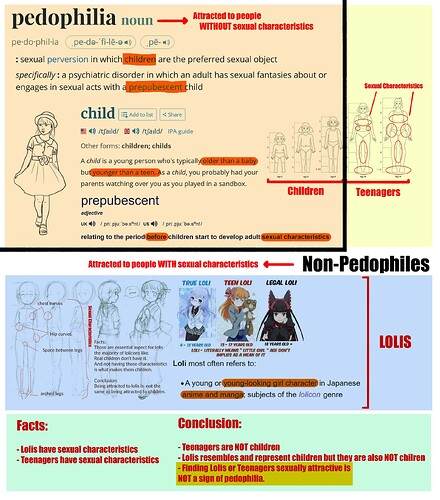As I’ve delved deeper into the societal responses to lolicon, I’ve come to realize that the strong aversion to it is rooted in a moral dissonance. This dissonance arises because lolicon characters are designed with pronounced adult sexual traits, which naturally evoke an attraction in most people (even non-lolicons and non-pedophiles). Yet, because these characters are also portrayed with youthful features, this attraction conflicts with the moral stance that finding children attractive is wrong. However, it’s not surprising, that ‘normal’ adults would find lolis appealing — it’s expected given the adult attributes they exhibit, that is not something we would find in real children (as illustrated in the infographic below). So, the moral conflict this creates is what leads to calls for its banishment.
What’s fascinating is the stark contrast in how society reacts to violence versus sexualization in media, particularly when children are involved. Fictional violence, even against children, doesn’t seem to generate the same level of moral conflict. People recognize such violence as reprehensible but also as purely fictitious, without the same impulse to ‘cleanse’ it from media. This absence of moral dissonance with violence may be due to a clearer separation in our minds between fiction and reality.

In contrast, lolicon challenges this separation. It triggers a discomfort that stems from an attraction to what’s perceived as a child’s image, despite being fictional. This discomfort seems to drive the narrative that lolicon could be a stepping stone to actual harmful behavior, despite evidence suggesting that attraction to lolis is based on their adult-like sexual characteristics — something real children do not possess. Understanding this, it becomes clear why the consumption of lolicon isn’t a reliable indicator of real-world behavior or intent.
It’s essential to recognize that our responses to media are complex and often driven by subconscious moral reasoning. Acknowledging the psychological mechanisms at play — the way we are drawn to adult sexual characteristics and our moral compass that dictates our conscious attitudes — is crucial in navigating this nuanced debate.
PS: Yeah, I used ChatGPT to summarize this whole idea for me, especially since, why not? ![]()

